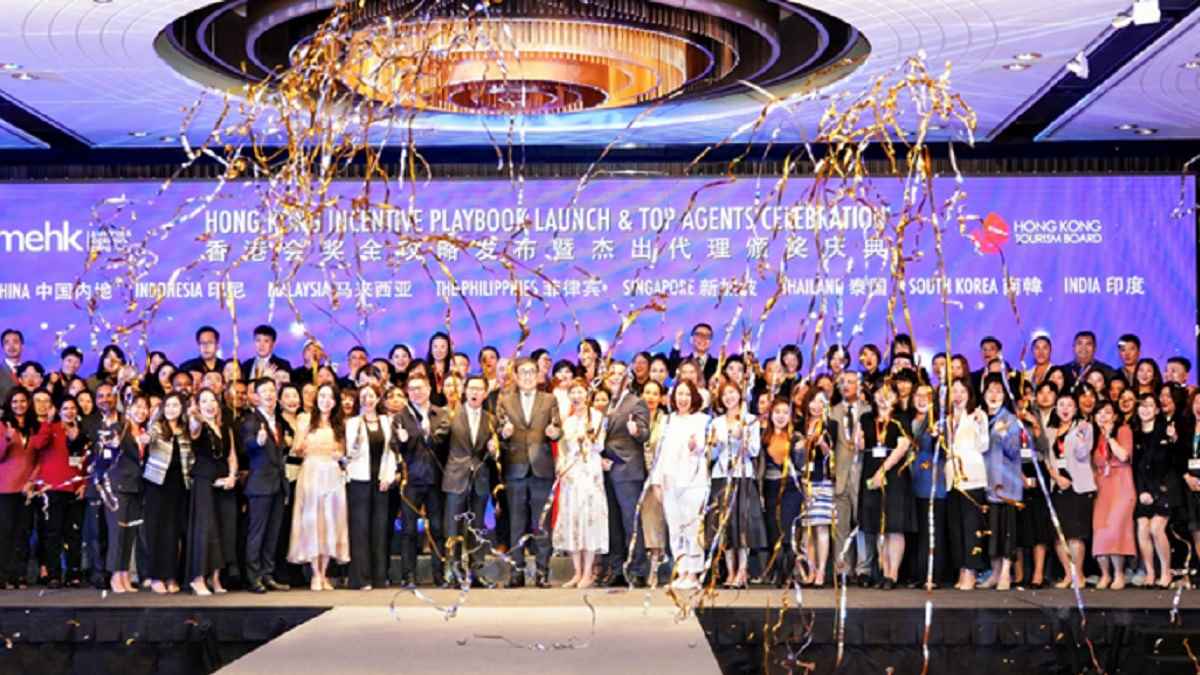Largest Celebration Ever with Over 110 Agents from Eight Markets to Experience Ultimate Hong Kong Adventure
HONG KONG SAR – Media OutReach Newswire – 29 April 2024 – Hong Kong Tourism Board (HKTB) launched a new campaign, “Hong Kong Incentive Playbook: Up the Game for Your Team”, with much fanfare at The Regent Hong Kong on 24 April 2024. The campaign curates over 100 new and authentic Hong Kong ideas to inspire and reward incentive groups in response to emerging incentive travel trends. Over 110 agents from Mainland, Southeast Asia, South Korea and India were invited to get exclusive first-hand experiences of Hong Kong’s rich and diverse incentive resources.
Dane Cheng, Executive Director of HKTB, shared his excitement, saying, “Last year, Hong Kong welcomed over 1.3 million MICE visitors, with the Meeting and Incentive (M&I) segment accounting for a staggering 65 per cent. This makes the share of M&I the most significant increase among the segments.”
“Building on this growth momentum, with the launch of the Hong Kong Incentive Playbook, we are taking it up a notch, inviting the incentive industry to experience Hong Kong like never before with the city’s newest, most authentic, and immersive incentive ideas. We are confident that Hong Kong will become the ultimate destination for incentive travel, offering unparalleled experiences for corporations to motivate and reward their teams, and create lasting memories in our city.”
Up the Incentive Game with a Playbook of New and Authentic Experiences
The “Hong Kong Incentive Playbook” covers over 100 new and unique incentive ideas under five themes: “Arts & Culture”, “Wellness & Nature”, “Neighbourhoods”, Nightlife & Parties”, and “Hong Kong Signatures”.
Experience Hong Kong’s world-class art and cultural scene, create traditional handicrafts, and escape the skyscrapers to immerse oneself in nature. Explore the city’s streets and alleys to embrace the blend of old and new urban landscapes. Enjoy Hong Kong-style day and night entertainment, engage in party activities, and visit iconic attractions. These are just some of the suggestions available in the comprehensive and game-changing guidebook for incentive travel planners to customise exciting itineraries in Hong Kong.
The HKTB has launched a campaign website and themed short videos for the Playbook in English and Chinese.
Largest-ever Top Agents Celebration and Familiarisation Trip Got First-hand Experience
Alongside the campaign launch, the HKTB hosted the largest-ever celebration for over 110 agents from Mainland, Indonesia, Malaysia, the Philippines, Singapore, Thailand, South Korea, and India to recognise their contribution to Hong Kong’s tourism and offer them a first-hand experience.
The launch ceremony and celebration were also an extravagant get-together to recognise overseas MICE agents for their contribution to bringing incentive groups to Hong Kong and fostering connections between the local, mainland, and overseas tourism industries.
Unlock New and Authentic Incentive Ideas to Create Extraordinary and Unforgettable Trips
From 23 to 26 April 2024, the HKTB curated unique itineraries and team activities for agents to explore Hong Kong’s incentives first-hand; all catered to the preferences of different source markets.
They relished a handful of incentive group exclusive experiences that showcase Hong Kong’s diverse offerings from day to night. These range from a soothing singing bowl session, a Tai Chi class with a stunning view, and an immersive Chinese fan painting workshop at the Hong Kong Palace Museum. Some also participated in an active team challenge at the West Kowloon Cultural District. To cap off the celebration, they enjoyed an evening of exclusive partying at a nightlife venue in Central.
Hong Kong – Delivering Wow Factors and a Top Choice for Incentives
A game-changing perspective
Zhang Yang, General Manager of Xi’an Cultural Tourism Co. Ltd. Beijing Branch, said: “Discovering Hong Kong’s exciting incentive possibilities through the ‘Hong Kong Incentive Playbook’ is a game-changer. The diverse attractions, nostalgic sites, and trendy bars offer unique experiences for all. I can’t wait for the opening of 11 SKIES, the perfect multifaceted destination for MICE travellers.”
“Must-have” incentive experiences
Maria Paz Alberto, President of Ark Travel Express Inc., said: “Beyond shopping and dining, Hong Kong offers diverse cultural encounters and unique activities like yoga and wellness events. The fan-painting workshop is a must-do for Filipino incentive travellers. We are excited to host a 50-person tour next month and introduce them to Hong Kong’s vibrant bar culture.”
An ideal destination
Aoyan Adhya, Assistant Vice President (MICE) at Thomas Cook Limited, India, said: “A city with excellent shopping, vibrant nightlife, and numerous tourist attractions, Hong Kong provides ideal conditions for hosting incentive tours from India. I was impressed by the M+ museum, while the singing bowl workshop left me feeling serene. I am enthusiastic about promoting Hong Kong’s nightlife hotspots in the future.”
Neighbourhoods a magnet
Kevin Kuswadi, Managing Director of Pelangi Tour, Indonesia, said: “Hong Kong’s new attractions, including the Palace Museum and M+, as well as its diverse array of experiences, are appealing to Indonesian travellers in search of novelty. The Neighbourhoods theme is sure to attract them like a magnet.”
From nightlife to wellness
Ji-Hyeon Ryu, Manager of Global Tour, South Korea, said: “We have seen a 1.4-fold increase in incentive travel inquiries to Hong Kong, with an insurance company planning a visit for up to 200 people. South Korean travellers like Hong Kong’s nightlife, and in the post-pandemic era, there is a growing interest in wellness and nature experiences.”
Thematic website of “Hong Kong Incentive Playbook”: https://www.hkincentiveplaybook.com
Thematic video of “Hong Kong Incentive Playbook” (English version): https://youtu.be/LfTSnSaWTME
Thematic video of “Hong Kong Incentive Playbook” (Simplified Chinese version): https://youtu.be/jroiU6iD3y4


 Business3 days ago
Business3 days ago
 Business3 days ago
Business3 days ago
 Business3 days ago
Business3 days ago
 Business3 days ago
Business3 days ago
 Business3 days ago
Business3 days ago
 Business2 days ago
Business2 days ago
 Business3 days ago
Business3 days ago
 Business3 days ago
Business3 days ago














